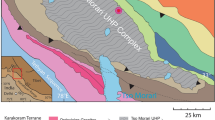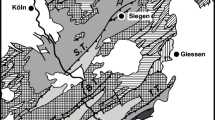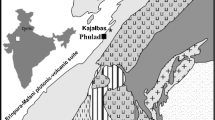Abstract
Siliceous dolomites and limestones contain abundant retrograde minerals produced by hydration-carbonation reactions as the aureole cooled. Marbles that contained periclase at the peak of metamorphism bear secondary brucite, dolomite, and serpentine; forsterite-dolomite marbles have retrograde tremolite and serpentine; wollastonite limestones contain secondary calcite and quartz; and wollastonite-free limestones have retrograde tremolite. Secondary tremolite never appears in marbles where brucite has replaced periclase or in wollastonite-bearing limestones. A model for infiltration of siliceous carbonates by CO2-H2O fluid that assumes (a) vertical upwardly-directed flow, (b) fluid flux proportional to cooling rate, and (c) flow and reaction under conditions of local equilibrium between peak temperatures and ≈400 °C, reproduces the modes of altered carbonate rocks, observed reaction textures, and the incompatibility between tremolite and brucite and between tremolite and wollastonite. Except for samples from a dolomite xenolith, retrograde time-integrated flux recorded by reaction progress is on the order of 1000 mol fluid/cm2 rock. Local focusing of flow near the contact is indicated by samples from the xenolith that record values an order of magnitude greater. Formation of periclase, forsterite, and wollastonite at the peak of metamorphism also required infiltration with prograde time-integrated flux approximately 100–1000 mol/cm2. The comparatively small values of prograde and retrograde time-integrated flux are consistent with lack of stable isotope alteration of the carbonates and with the success of conductive thermal models in reproducing peak metamorphic temperatures recorded by mineral equilibria. Although isobaric univariant assemblages are ubiquitous in the carbonates, most formed during retrograde metamorphism. Isobaric univariant assemblages observed in metacarbonates from contact aureoles may not record physical conditions at the peak of metamorphism as is commonly assumed.
Similar content being viewed by others
Author information
Authors and Affiliations
Additional information
Received: 19 September 1995 / Accepted: 14 March 1996
Rights and permissions
About this article
Cite this article
Ferry, J. Prograde and retrograde fluid flow during contact metamorphism of siliceous carbonate rocks from the Ballachulish aureole, Scotland. Contrib Mineral Petrol 124, 235–254 (1996). https://doi.org/10.1007/s004100050189
Issue Date:
DOI: https://doi.org/10.1007/s004100050189




